"Justice
for Hungary" - a historic flight, 1931
by Bryan Dawson
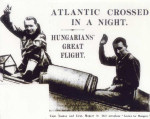 July,
1931, newspapers all over the world reported on the front page that two
Hungarian pilots, Alexander Magyar and George Endresz (Endres), had crossed
the Atlantic Ocean from the United States to Hungary in a Lockheed-Sirius
airplane named "Justice for Hungary." The flight was intended to call attention to the dismemberment of Hungary after World War I. It
was a spectacular success. July,
1931, newspapers all over the world reported on the front page that two
Hungarian pilots, Alexander Magyar and George Endresz (Endres), had crossed
the Atlantic Ocean from the United States to Hungary in a Lockheed-Sirius
airplane named "Justice for Hungary." The flight was intended to call attention to the dismemberment of Hungary after World War I. It
was a spectacular success. 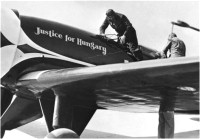 On
July 15, 1931, the trans-Oceanic flight left Harbor-Grace for Budapest
on a non-stop flight of twenty-six hours. The historic flight took 26
hours and 20 minutes (Charles Lindbergh's flight in 1927 took six hours
longer) and marked the first time that an airplane crossing the ocean had radio contact both with the starting and
landing aerodromes. It was also the first time such a flight was used
for political purposes. The pilots were received as heroes in Budapest. On
July 15, 1931, the trans-Oceanic flight left Harbor-Grace for Budapest
on a non-stop flight of twenty-six hours. The historic flight took 26
hours and 20 minutes (Charles Lindbergh's flight in 1927 took six hours
longer) and marked the first time that an airplane crossing the ocean had radio contact both with the starting and
landing aerodromes. It was also the first time such a flight was used
for political purposes. The pilots were received as heroes in Budapest.
Where did this idea come from?
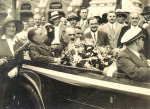 On
New Year's Day, 1929, the American Hungarian Federation issued a proclamation
to the "people of Magyar America" to send representatives to
a grand assembly at Buffalo, New York, to establish unity, On
New Year's Day, 1929, the American Hungarian Federation issued a proclamation
to the "people of Magyar America" to send representatives to
a grand assembly at Buffalo, New York, to establish unity, 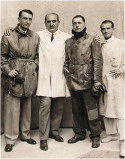 express
everlasting loyalty to America, and lay down the lines along which a just
revision of the Treaty of Trianon could be rendered possible. Mark Imre
Major wrote: "The grand assembly met on May 29, 1929, in an optimistic
but solemn mood. Fraternal organizations, the churches, and the press
were well represented."1 express
everlasting loyalty to America, and lay down the lines along which a just
revision of the Treaty of Trianon could be rendered possible. Mark Imre
Major wrote: "The grand assembly met on May 29, 1929, in an optimistic
but solemn mood. Fraternal organizations, the churches, and the press
were well represented."1
The American
Hungarian Federation obtained full support and was recognized by the United
States government as the official spokesman of Hungarian-Americans.2 One of 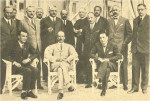 the American Hungarian Federation's first purposes was to coordinate efforts for the revision of the Treaty
of Trianon and bring to the attention of politicians and lawmakers
the importance of such a revision. The re-invogorated Federation would
represent all Hungarians in America and fought with a united will for
Hungary's sake. Hungarian Americans across the country supported the effort. Future AHF President, Dr. Arpad Barothy delivered the opening address at the 1929 Chicago Convention and diplomatically outlined the plan for the revision of the peace treaty of Trianon. He had also been appointed by the United States government to the committee for organization of the Eastern division of the Hungarian American Loyalty League. the American Hungarian Federation's first purposes was to coordinate efforts for the revision of the Treaty
of Trianon and bring to the attention of politicians and lawmakers
the importance of such a revision. The re-invogorated Federation would
represent all Hungarians in America and fought with a united will for
Hungary's sake. Hungarian Americans across the country supported the effort. Future AHF President, Dr. Arpad Barothy delivered the opening address at the 1929 Chicago Convention and diplomatically outlined the plan for the revision of the peace treaty of Trianon. He had also been appointed by the United States government to the committee for organization of the Eastern division of the Hungarian American Loyalty League.
 With
its new mandate, a few months later in Budapest, AHF became a founding
member of the Hungarian World Alliance at the first International Congress
of Hungarians whose members included representatives of Hungarian communities
from many parts of the world and friends of Hungary from foreign countries.
Mark Imre Major continues: "The first congress met in Budapest from
August 22 to August 24, 1929 with a membership of 746 representatives
of which 477 were Hungarians living abroad, and 269 were foreign friends
of Hungary. Eighty-eight Hungarian associations located in foreign countries
were represented. With
its new mandate, a few months later in Budapest, AHF became a founding
member of the Hungarian World Alliance at the first International Congress
of Hungarians whose members included representatives of Hungarian communities
from many parts of the world and friends of Hungary from foreign countries.
Mark Imre Major continues: "The first congress met in Budapest from
August 22 to August 24, 1929 with a membership of 746 representatives
of which 477 were Hungarians living abroad, and 269 were foreign friends
of Hungary. Eighty-eight Hungarian associations located in foreign countries
were represented.
Count Albert Apponyi, Hungary's grand old man, was elected
chairman of the Congress. The Congress opened in the entrance hall of
the National Museum with a welcoming speech by Baron Sigismond Perenyi,
President of the Hungarian Revisionist League. Jozsika Herczeg, President
of the American Hungarian Federation, in reply spoke for the foreign citizens
of Hungarian origin, declaring that they had come to the mother country
with a unity of feeling as regards the work of Hungarian revisionism.
 The
delegates of the Congress were received by the Regent. He pointed out
that the mission of the Hungarians abroad was to develop their talents
and abilities. While Hungarians living abroad consider themselves offshoots
of the old tree, thriving on foreign soil, they should not forget that
they derived their culture from the mother country which expects their
support now, more than at any other time in her history. "Be,"
the Regent declared, "what you must be: good citizens of your new
country, and good diplomats of your old fatherland".3 The
delegates of the Congress were received by the Regent. He pointed out
that the mission of the Hungarians abroad was to develop their talents
and abilities. While Hungarians living abroad consider themselves offshoots
of the old tree, thriving on foreign soil, they should not forget that
they derived their culture from the mother country which expects their
support now, more than at any other time in her history. "Be,"
the Regent declared, "what you must be: good citizens of your new
country, and good diplomats of your old fatherland".3
One of its first aims of both organizations was to unify and coordinate
worldwide efforts to revise the Treaty of Trianon.
They decided to call attention to the Hungarian boundary problem in the
a spectacular way. Thus the "Justice for Hungary" idea was born.
Time Magazine on May 30, 1932 wrote a follow up article to their coverage
of Endres and Magyar. They wrote: "From Budapest to Rome for the
first congress of transocean flyers, flew Capt. George ("Yurga")
Endres in the Lockheed "Justice for Hungary" which he flew from
the U.S. last year. Just before the take-off, Capt. Alexander Magyar,
his transatlantic flying companion with whom Capt. Endres later quarreled,
withdrew from the Rome jaunt. In his place went Capt. Julius Bittay. Arrived
over Littorio Airport the plane went into a sideslip, unaccountably crashed.
Before the eyes of other famed airmen gathered to greet them, Flyers Endres
and Bittay died in flames."4There
is a memorial
to the pilots in Rome.
The Endres Memorial Foundation
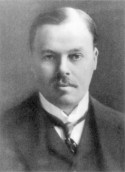 One
of the supporters of the flight was Britain's
Harold Harmsworth, Lord then 1st Viscount and Baron Rothermere, was
President of the British
Air Council (to manage British Air Forces in WWI) under Lloyd George.
Lord Rothermere strongly supported revision of the Treaty
of Trianon in favor of Hungary, to the extent that he was offered
the Hungarian Crown in 1927. He declined, but purchased estates in Hungary
in case Britain should fall to a Soviet invasion.5 Lord Rothermere was a newspaper tycoon and used his position to support
Hungary. Time Magazine wrote in 1928: 'Viscount Rothermere,* 60, who for
years has trumpeted with his Daily Mail and other blatant new organs:
Restore to Hungary at least a part of her dismembered lands, which now
belong to Czechoslovakia, Jugoslavia and Rumania!"6 There is a memorial to Rothermere in Budapest. Lord Rothermere offered
$10,000.00 to the first pilots to successfully cross from the Americas
to Hungary. His great nephew now heads the Endres
Memorial Trust set up to commemorate the memory of the Hungarian aviation
pioneer, György Endresz, and to further the cause of co-operation
between Hungary and England. Endresz's widow moved to England, where she
actively helped the Hungarian community. She died in 1990 and, in her
will, offered part of her estate to a charity to be set up to foster British-Hungarian
co-operation. In 1993 this charity was formed. Each year the Foundation
runs a competition to select talented Hungarian English language teachers,
and invite them to a brief postgraduate course in the UK. The Foundation
is also involved in rebuilding schools in the Ukraine.7 AHF thanks the Endres Memorial Foundation and Cleveland Memory for
some of the historic pictures seen here. One
of the supporters of the flight was Britain's
Harold Harmsworth, Lord then 1st Viscount and Baron Rothermere, was
President of the British
Air Council (to manage British Air Forces in WWI) under Lloyd George.
Lord Rothermere strongly supported revision of the Treaty
of Trianon in favor of Hungary, to the extent that he was offered
the Hungarian Crown in 1927. He declined, but purchased estates in Hungary
in case Britain should fall to a Soviet invasion.5 Lord Rothermere was a newspaper tycoon and used his position to support
Hungary. Time Magazine wrote in 1928: 'Viscount Rothermere,* 60, who for
years has trumpeted with his Daily Mail and other blatant new organs:
Restore to Hungary at least a part of her dismembered lands, which now
belong to Czechoslovakia, Jugoslavia and Rumania!"6 There is a memorial to Rothermere in Budapest. Lord Rothermere offered
$10,000.00 to the first pilots to successfully cross from the Americas
to Hungary. His great nephew now heads the Endres
Memorial Trust set up to commemorate the memory of the Hungarian aviation
pioneer, György Endresz, and to further the cause of co-operation
between Hungary and England. Endresz's widow moved to England, where she
actively helped the Hungarian community. She died in 1990 and, in her
will, offered part of her estate to a charity to be set up to foster British-Hungarian
co-operation. In 1993 this charity was formed. Each year the Foundation
runs a competition to select talented Hungarian English language teachers,
and invite them to a brief postgraduate course in the UK. The Foundation
is also involved in rebuilding schools in the Ukraine.7 AHF thanks the Endres Memorial Foundation and Cleveland Memory for
some of the historic pictures seen here.
---------------------------------
1,3 - Mark
Imre Major : American Hungarian Relations 1918-1944
2 - Cleveland
Memory: The World Wars and their Impact on Hungarian-Americans
4 - Time
Magazine: May 30, 1932
5 - Wikipedia
6 - Time
Magazine: Homage to Harmsworth, Lord Rothermere
7 - Endres Memorial
Foundation
[>> Go to More AHF History] [>>
Go to all AHF news]
| 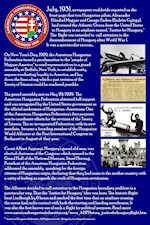
Congressional Display:
AHF and the "Justice for
Hungary" movement calling
attention to the Tragedy of Trianon
The 1907 Kohányi Szózat (Appeal)
“Amerika egy millió magyarja, nemcsak hogy követeljük, de keresztül is visszük azt, hogy Magyarország népének ugyanabban a szabadságban, ugyanabban az igazságban, ugyanabban a jólétben legyen resze, mint amely szabadság, igazság, es jólét abban az Amerikában van amelynek lakósai, polgárai vagyunk.”
“We, America’s 1 million Hungarians, do not just demand, but will work to ensure that the people of Hungary may partake in the same freedom, the same justice, the same prosperity as we, citizens of America, partake.”
- Kohanyi Tihamer, AHF President, 1907
Links
AHF's 100 YEARS
CONGRESSIONAL DISPLAY
(by Bryan Dawson:
click on each
image for a larger version)
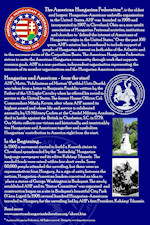
AHF in the Beginning:
1906 and Budapest's
George Washington Memorial
[read more]
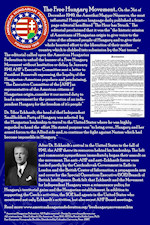
AHF, Tibor Eckhardt, and
the "Free Hungary Movement"
seeking to extract Hungary
from the Axis sphere
[read more]
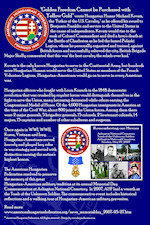
AHF Honoring our
Heroes at the Arlington
National Cemetery
[read more]
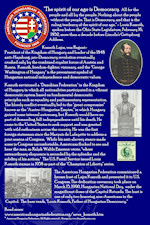
AHF and the Kossuth
Bust in the US Capitol
[read more]
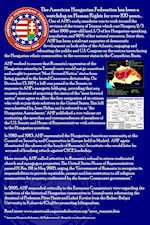
AHF as a watchdog for
human rights in Rumania
[read more]
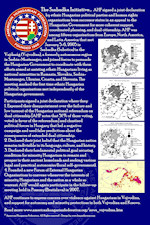
AHF as a watchdog for
human rights in Vojvodina
and the MÁÉRT movement
[read more]
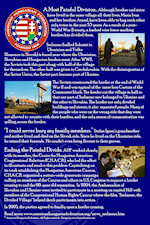
AHF as a watchdog for
human rights in Carpatho-Ukraine:
The Divided Village of Szelmenc
[read more]
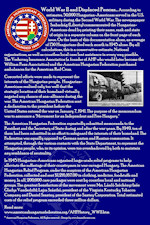
AHF relief efforts during WWII
[Read More]
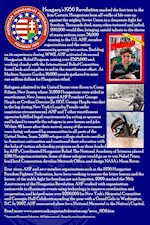
AHF relief efforts during
the 1956 Hungarian Revolution
[read more]
Join online!

Help us help the community!
Support us securely online.
[<< back to all AHF news] |



